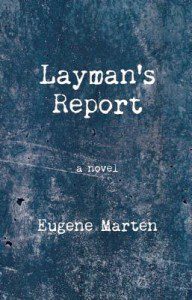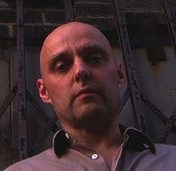
With novels that use an actual person or event as their fictional subject, a common question among readers is, “What does this book add to what we already know?” Those readers have the wrong mathematical operation in mind. It’s not a matter of addition; it’s a matter of division.
Think of it as a fraction. The person or event is the numerator, and the author is the denominator. By fictionalizing a person or event an author breaks them down into an entirely new number. Call it a quotient. Coming Through Slaughter is the number created by musician Buddy Bolden being divided by novelist Michael Ondaatje. Wolf Hall is the number created by English statesman Thomas Cromwell being divided by novelist Hilary Mantel. The World As I Found It is the number created by philosopher Ludwig Wittgenstein being divided by novelist Bruce Duffy. What readers should ask is, “How does this book break down what we already know?”
The most recent novel by Eugene Marten proves he can do the math. Layman’s Report concerns Fred A. Leuchter, Jr., a manufacturer of execution equipment and author of Holocaust-denial material who, in 1999, was the subject of the Errol Morris documentary Mr. Death: The Rise and Fall of Fred A. Leuchter, Jr. It is not surprising Mr. Death inspired Marten to write this novel. Throughout the documentary, Leuchter exhibits qualities similar to those of Marten’s earlier protagonists: the alienation of Sloper in Waste; the issues of punishment and redemption that concern the unnamed narrator of In the Blind; the paranoia of Jelonnek in Firework.
In Layman’s Report, Marten splinters the reality of Fred Leuchter into three sections, all of which combine to provide a deeper, broader view of a complicated man. The first section is the strongest one. Almost a novella, not only in length but also in scope, the section follows a petty criminal who, after going on a spree of theft, murder, and rape, is imprisoned and eventually executed. Although Leuchter does not appear in this section, it is connected to him through its portrayal of an electric-chair execution, the brutality of which Leuchter attempts to mitigate during his career. Consider what happens after the switch is thrown. “Now the blue-white flames flared from both sides of the mask, and blood dripped from behind it onto his white shirt from his mouth and nose, and then from two new holes in his face as his eyeballs burst with the steam pressure in his skull.”
The second section of the novel follows the career of its titular layman. Leuchter sees himself as a humanitarian of capital punishment. “He believed in the body and soul and the occasional necessity of evil. It was not a perfect world, but the next one would be. You helped what you could help. He would be the middleman.” Due to his experience repairing and manufacturing execution equipment, Leuchter is commissioned by a Holocaust denier to travel to Auschwitz, investigate the camps, and determine, in his “expert” opinion, whether mass executions by gassing were feasible. The result is what has become known as the Leuchter Report. Despite his lack of training and qualifications, Leuchter stands by his findings that the gas chambers could not have been used for mass extermination, even after the science behind his methods is shown, by actual experts, to be bogus.

One of the most interesting aspects of this novel is that Marten chooses to include the making of the film that inspired it. Layman’s Report is therefore as much about Leuchter as it is about the documentary Mr. Death. It is a work of art based on not just an actual person but also another work of art based on that same person. In the theater where Leuchter first sees the documentary, which the New York Times would describe as “a study of hubris, the myth of objectivity, and the fatal attraction of needy people to attention and flattery even if it comes from the wrong quarters,” all of those layers are folded together as Marten enters Leuchter’s point of view: “He saw himself being heard and understood, his thoughts becoming words becoming light shining on smooth blank faces, and those faces ripening in that light.”
The final section of the novel, which switches to the first-person point of view, narrated by Leuchter closer to the present day, is its least successful one. Marten has no trouble chewing what he’s bitten off with Layman’s Report. He just doesn’t manage to swallow it. How the 9/11 Truth movement relates to Holocaust denial, a connection introduced in the third section, is under-developed, and a brief subplot involving potential terrorists, also introduced in the third section, feels as though it belongs in a different book.
Nonetheless Layman’s Report is good enough to draw comparisons to what is arguably Don DeLillo’s best novel. Like Underworld, it opens with a self-contained set piece that is fairly close to perfect. Like Underworld, that set piece is followed by an unwieldy narrative. And like Underworld, that narrative is toppled by its own ambition, which makes it all the more admirable. The most impressive characteristic of Layman’s Report is Marten’s refusal to write in received language. Instead of “They kissed” he uses “Their mouths bumped.” Instead of “line of work” he uses “way to work.” Instead of “He says it” he uses “He makes himself say it.” A novel concerned with silence and sound, Layman’s Report is full of quiet prose interrupted by the emphatic check marks, notes, and exclamation points of an impressed reader.
An exchange of dialogue about patents, from early in the book, could also apply to the writing of novels. “There anything left to invent?” one characters says, to which another responds, “Not until somebody invents it.” Layman’s Report was written by one of the best inventors working today.




